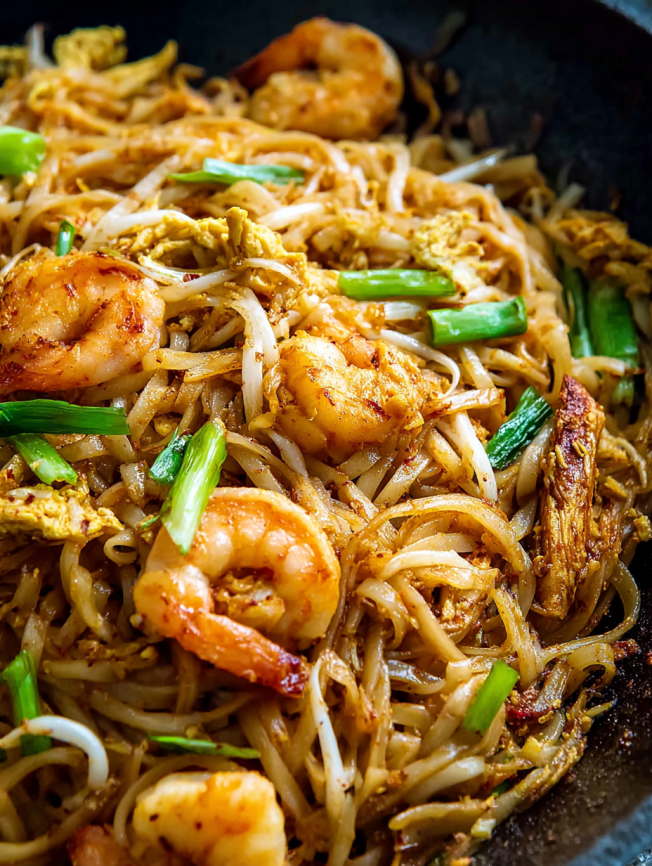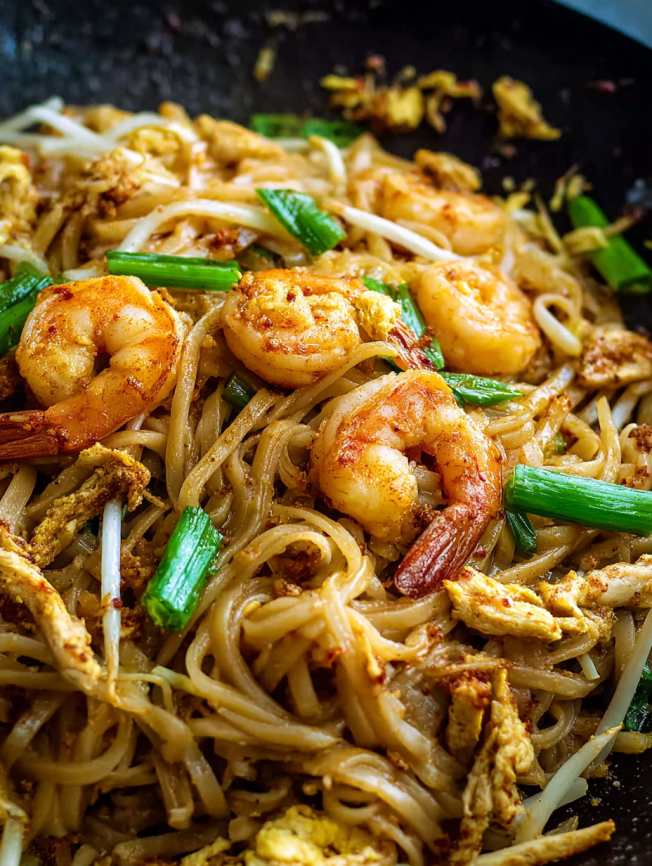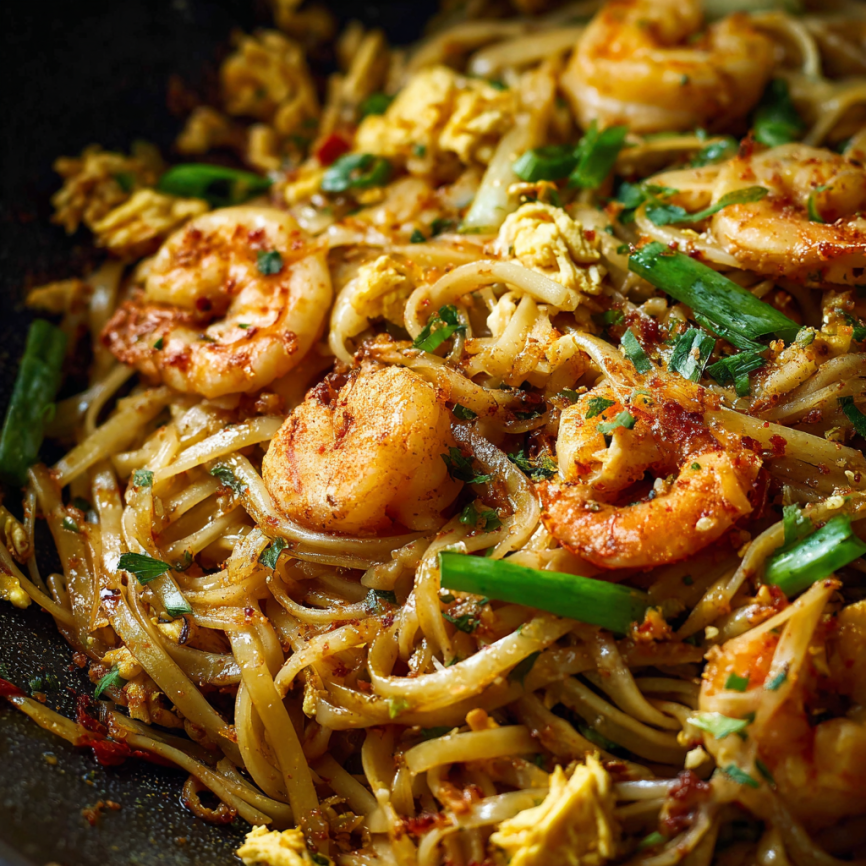My love affair with Pad Thai began during a backpacking trip through Bangkok’s bustling street markets. Watching skilled vendors toss noodles in massive woks while balancing sweet, sour, and salty flavors seemed like pure magic. Years later, after countless attempts to recreate that perfect bite, I’ve developed this recipe that brings those authentic Thai flavors straight to your kitchen.
Nothing compares to the satisfaction of mastering this iconic dish at home. The combination of silky rice noodles, perfectly balanced sauce, and fresh toppings creates a symphony of textures and flavors that transport you directly to Thailand’s vibrant food scene.
Why This Pad Thai Recipe Will Become Your Go-To
Authentic Flavor Profile
This recipe captures the essential balance that makes Pad Thai legendary – the sweet depth from brown sugar, the tangy brightness from tamarind and lime, and the umami richness from fish sauce. Together, these elements create the complex flavor profile that distinguishes authentic Pad Thai from westernized versions.
Quick and Accessible
Despite its exotic reputation, this dish comes together in just 25 minutes using ingredients readily available at most grocery stores. Furthermore, the technique is straightforward enough for beginners while still delivering restaurant-quality results.
Customizable and Versatile
Whether you’re vegetarian, prefer extra protein, or want to adjust the spice level, this recipe easily adapts to your preferences. Additionally, the cooking method works perfectly whether you’re using a traditional wok or a large skillet.
Ingredients
Prep Time: 10 minutes
Cook Time: 15 minutes
Total Time: 25 minutes
Servings: 4 servings
Noodles and Base
- 14 ounces dried rice noodles
- 2 tablespoons vegetable oil
- 1 tablespoon garlic, minced
Protein Components
- ½ cup firm tofu, diced
- 1 large egg
- ½ cup boneless skinless chicken breast, sliced
- 4 ounces large shrimp (16/20 count), peeled and deveined
Signature Sauce
- 2 tablespoons fish sauce
- 2 tablespoons brown sugar
- 4½ tablespoons tamarind paste
- 1½ teaspoons lime juice
- 1½ teaspoons rice vinegar
Fresh Toppings and Garnishes
- 1 teaspoon paprika
- ⅓ cup green onion, chopped into 2-inch pieces
- 2 tablespoons unsalted roasted peanuts, chopped
- ½ cup fresh bean sprouts
Traditional Accompaniments
- Lime wedges
- Crushed red pepper flakes
- Extra chopped peanuts
- Fresh cilantro sprigs
Step-by-Step Instructions
Preparing the Noodles
Begin by heating a large pot of water until it reaches lukewarm temperature (80-90°F/27-32°C), then turn off the heat. This gentle temperature is crucial for achieving the perfect noodle texture. Add the rice noodles and allow them to soak until they become flexible and solid but not completely cooked, approximately 5-10 minutes.
Once properly soaked, drain the noodles thoroughly and rinse with cold water to stop the cooking process. This technique prevents the noodles from becoming mushy during the final stir-fry stage.
Creating the Sauce
In a medium-sized bowl, whisk together all sauce ingredients: fish sauce, brown sugar, tamarind paste, lime juice, and rice vinegar. Stir until the brown sugar completely dissolves and the mixture becomes smooth. This balanced sauce is the heart of authentic Pad Thai flavor.
Building the Stir-Fry Base
Heat your wok or large sauté pan over medium-high heat until it’s smoking hot. Add the vegetable oil, and once it shimmers, add the minced garlic. Stir constantly for 15 seconds to release the aromatic oils without burning.
Cooking the Proteins
Add the diced tofu first and stir-fry for 1 minute until it develops a light golden color. Push the tofu to one side of the pan to create space for the egg. Crack the egg into the empty space and allow it to set for a few seconds before scrambling.
Next, add the sliced chicken and mix it with the still-runny egg, allowing the egg to coat the meat as it cooks. Continue stir-frying until the chicken is just cooked through, about 2 minutes. Finally, add the shrimp and cook until they just turn pink, approximately 1 minute.
Combining Everything
Add the soaked noodles to the pan, stirring to combine all ingredients. Cook for 2 minutes to soften the noodles further, then pour the prepared sauce over everything. Toss continuously to ensure even coating and prevent sticking.
Final Touches
Turn off the heat and add the paprika, tossing until the noodles turn slightly red in color. This gives the dish its characteristic appearance. Add the chopped green onions and allow them to wilt from the residual heat of the noodles.

Serving Suggestions
Traditional Presentation
Transfer the Pad Thai to a large serving platter and top with fresh bean sprouts and chopped peanuts. Arrange lime wedges around the edges for guests to squeeze over their portions according to taste.
Individual Plating
For a more refined presentation, divide the Pad Thai among four individual plates. Garnish each serving with a small mound of bean sprouts, a sprinkle of peanuts, and a lime wedge.
Street Food Style
Serve in takeout containers or banana leaves for an authentic street food experience. Provide small bowls of extra chopped peanuts, chili flakes, and lime wedges on the side.
Recipe Variations
Vegetarian Version
Simply omit the chicken and shrimp while doubling the tofu. You can also add extra vegetables like julienned carrots, bell peppers, or snap peas for additional color and nutrition.
Seafood Lover’s Pad Thai
Replace the chicken with additional shrimp or add scallops, squid, or crab meat. Seafood versions cook quickly, so adjust timing accordingly to prevent overcooking.
Spicy Pad Thai
Add 1-2 Thai chilies or a teaspoon of chili garlic sauce to the sauce mixture. Alternatively, serve with sriracha or sambal oelek on the side for individual heat adjustment.
Protein-Packed Version
Include both chicken and shrimp as written, but also add some cooked ground pork or beef for an extra hearty meal.
Make-Ahead Tips
Sauce Preparation
The sauce can be prepared up to 3 days in advance and stored in the refrigerator. This actually improves the flavor as the ingredients meld together over time.
Noodle Preparation
Soak the rice noodles up to 4 hours ahead of time. After draining and rinsing, toss them with a small amount of oil to prevent sticking and store covered in the refrigerator.
Protein Prep
Slice the chicken and devein the shrimp up to 24 hours in advance. Store them separately in airtight containers in the refrigerator until ready to cook.
Complete Make-Ahead Strategy
While Pad Thai is best served immediately, you can prepare all components separately and then quickly assemble when ready to eat. This approach works well for meal prep or entertaining.
Essential Notes
Noodle Texture Tips
Using firm tofu is crucial because it holds up to the vigorous stir-frying motion without breaking apart. The cubes should be large enough to maintain their shape but small enough to distribute evenly throughout the dish.
Egg Technique
Allow the egg to just set before adding the chicken so it clings to and coats the meat as it cooks. This creates silky ribbons of egg throughout the dish rather than scrambled chunks.
Shrimp Timing
Add the shrimp last and cook for just one minute because it cooks extremely fast. Overcooked shrimp becomes rubbery and tough, so watch it carefully during this final step.
Temperature Control
Maintain high heat throughout the cooking process to achieve the characteristic “wok hei” – the smoky flavor that comes from proper high-heat stir-frying.

Frequently Asked Questions
Q: Can I substitute the tamarind paste with something else? A: While tamarind provides the authentic sour note, you can substitute with additional lime juice mixed with a small amount of worcestershire sauce. However, the flavor will be slightly different from traditional Pad Thai.
Q: What if I can’t find fish sauce? A: Fish sauce is essential for authentic flavor, but vegetarians can substitute with soy sauce mixed with a small amount of seaweed flakes. The umami depth won’t be quite the same, but it will still be delicious.
Q: How do I prevent the noodles from sticking together? A: Proper soaking temperature is key – too hot and they’ll overcook, too cool and they won’t soften properly. Additionally, rinse them with cold water after soaking and toss with a small amount of oil if storing.
Q: Can I make this dish gluten-free? A: Yes! Rice noodles are naturally gluten-free, and most fish sauces are as well. Just double-check your fish sauce label to ensure it doesn’t contain wheat or other gluten-containing ingredients.
Q: What’s the best way to reheat leftovers? A: Reheat in a wok or large skillet over medium-high heat with a splash of water or oil. Stir frequently to prevent sticking. Avoid microwaving as it can make the noodles gummy.
Q: How spicy is this recipe? A: This version is mild and family-friendly. The paprika adds color and slight warmth but not heat. Add fresh chilies or chili sauce if you prefer more spice.
Q: Can I prep this dish for a dinner party? A: Absolutely! Prepare all ingredients in advance and arrange them near your cooking station. The actual cooking only takes about 8-10 minutes, making it perfect for entertaining when you want to cook fresh but minimize prep time.
Nutrition Information (per serving):
- Calories: 618
- Protein: 20g
- Carbohydrates: 104g
- Fat: 13g
- Fiber: 4g
- Sodium: 991mg

